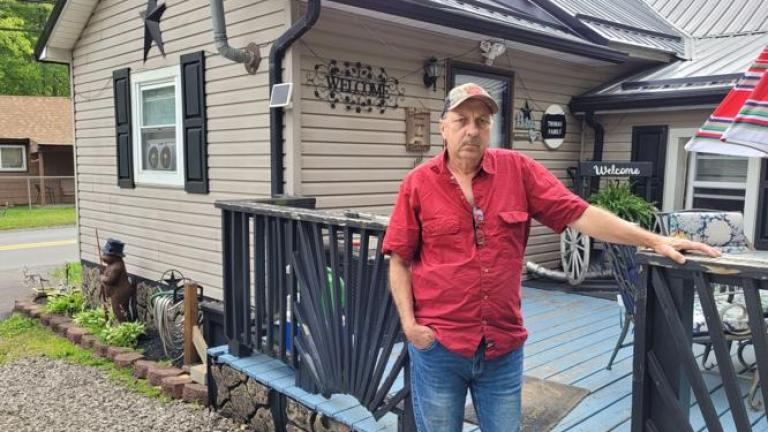
This story by ESI Journalism Fellow Mike Tony was originally published as part of the Charleston Gazette-Mail's "Facing Flooding" series, where it appears with additional photos and resources.
__________
The science was fine.
But the man who West Virginia reelected governor by 33 points had questioning it down to a science all its own.
“In regard to climate change, I don’t know if it’s for real or not,” Gov. Jim Justice said. “I really don’t know.”
Justice was questioning not just climate change, but the need to do something about it during a March 2022 speech at the West Virginia Capitol. The coal magnate advocated tapping further into the state’s fossil fuels as a response to oil producer Russia invading Ukraine.
Justice had questioned the scientific consensus that climate change is real and caused by human activity during his successful run to become governor in 2016.
That year, the Environmental Protection Agency published an analysis finding most of West Virginia had warmed one-half to one degree Fahrenheit in the last century. The agency noted a changing climate is likely to increase flooding.
“[T]his world is threatened beyond belief, and we have got to shove it aside,” Justice said of climate concern during his 2022 speech.
But a central threat to West Virginians rooted in climate change and escalating on Justice’s watch can’t be shoved aside.
Flood events quadrupled in the 1,881 days Justice had been governor up to his March 11, 2022 speech, compared with the previous 1,881-day period, according to National Oceanic and Atmospheric Administration data.
West Virginia had suffered 139 flood events in the former period starting in November 2011. During Justice’s administration up to his March 2022 speech, West Virginia suffered 566 flood events — a 407% increase consisting of one such event every three days.
Experts say those numbers are poised to get worse.
The NOAA says West Virginia’s number and intensity of extreme precipitation events are projected to increase along with its winter and spring precipitation amounts, creating an elevated flooding risk.
More than half of West Virginia’s critical infrastructure — including fire, police and power stations — is at risk of becoming inoperable due to flooding, according to a 2021 study by the First Street Foundation, a nonprofit that quantifies climate risks. West Virginia’s share of critical infrastructure found to be at risk was higher than that of any other state.
West Virginia’s high concentration of people living along narrow valleys and steep slopes makes the state especially flood-prone.
But instead of getting a grip on climate change, Justice has suggested letting go.
“We cannot continue to hold onto something that we don’t really even know,” Justice said during his speech last year.
Darrell Thomas doesn’t think much of Justice.
Sitting outside his Minden home on West Virginia’s 160th birthday on a clear June afternoon, Thomas, who goes by “Butter,” makes it clear he doesn’t believe in the state’s political establishment.
“The governor right on down, you just take your pick,” Thomas said. “If you’re a politician, you hate Minden.”
Thomas believes Justice and other state leaders haven’t done enough to protect his Fayette County community from decades of industrial contamination the EPA fears will be exacerbated by future flooding.
The EPA has proposed spending $15.5 million to excavate and dispose of soil contaminated by a group of chemicals known to cause cancer at a site in the agency’s Superfund program responsible for cleaning up some of the country’s most contaminated land.
The EPA attributes the soil contamination to polychlorinated biphenyls, better known as PCBs, manufactured through the 1970s that the agency said were released to the environment on the site of a company that built electrical substations for the coal mining industry.
The agency indicated flooding of a nearby creek could result in releases of contaminated soil migrating to downstream wetlands and residential properties.
The EPA noted in its proposal that flood events had occurred in Minden in June 2016, June 2017, June 2020 and July 2022.
Thomas has noticed flooding impacts have gotten worse over the years in Minden, a disturbing trend he attributed to erosion allowing smaller rainfall amounts to inflict greater damage.
But Thomas dismissed climate change as a factor behind the flooding.
“Being an old man here in West Virginia, I like them 45- and 50-degree winters myself,” Thomas, 64, said. “If that’s climate change, bring it on, as far as I’m concerned.”
Data published by the Yale Program on Climate Change Communication last year suggest West Virginia’s share of citizens who believe global warming is happening is the lowest in the country.
West Virginia’s 57% of respondents who said global warming is happening was the lowest clip among all 50 states, 15 percentage points below the national average.
The share of West Virginians responding that there was “a lot of disagreement” among scientists about whether global warming is happening — 34% — was just 10 percentage points behind the share indicating that most scientists think global warming is happening — the correct response.
The Yale Program on Climate Change Communication studies public opinion and behavior regarding climate action.
Nicolas Zegre, associate professor of forest hydrology at West Virginia University, noted deforestation for pipelines and surface mines results in “fundamentally altering” the relationship between rainfall and water runoff. Zegre observed that the more carbon dioxide is emitted into the atmosphere, the warmer the atmosphere and the more intense rainfall events will become.
“We have to move on this transition away from a carbon-based economy,” Zegre said.
Zegre singled out the Mountain Valley Pipeline, a project uniformly supported by West Virginia’s congressional delegation and Justice. Mountain Valley Pipeline LLC, the joint venture behind the 303.5-mile, unfinished gas pipeline, estimates the pipeline would result in 48 million to 57 million metric tons of greenhouse gases annually.
West Virginia and Virginia environmental regulators have fined Mountain Valley Pipeline more than $2.7 million for sedimentation and erosion issues, and landowners along the pipeline route have complained of flooding impacts stemming from deforestation to accommodate the project.
West Virginia’s 15% clip of citizens living in poverty on average from 2019 to 2021 was fifth-highest in the nation.
Nearly a quarter of West Virginia’s 862 public water systems were considered enforcement priorities in 2021 under the Safe Drinking Water Act, according to EPA data. Enforcement priority status means a public water system has unresolved serious, multiple or continuing violations of federal drinking water quality standards.
From January 2013 through March 2023, nearly 1,500 flood and flash-flood events resulted in 31 deaths and $221.5 million in property damage in West Virginia, according to NOAA data. Floods are longer-term events that may last days or weeks, while flash floods are caused by heavy rainfall in a short period of time, usually under six hours.
But as flooding drenches more and more of West Virginia, climate and political experts see momentum pushing West Virginians toward embracing greater climate action rather than fossil fuel extraction — and ways to accelerate that momentum.
“As more and more people experience what a diversified economy could be … I think more and more people are accepting that change is OK,” Zegre said.





